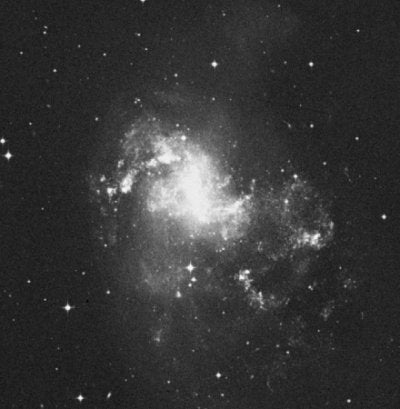Until recently, black holes were thought to come in only two sizes — small and large. Recent studies, however, have suggested the controversial existence of a third, medium-sized version of these cosmic beasts. Using the European Space Agency’s XMM-Newton satellite, astronomers have found fresh evidence in a spiral galaxy 10 million light-years distant that supports the reality of the new, exotic species of black holes.
The subject of much debate over the past few years, middleweight black holes are several hundreds to tens of thousands times more massive than their stellar cousins found scattered across our own Milky Way Galaxy. Created by supernova explosions, the small-sized stellar black holes are mere remnants of massive stars only a few times the size of our own sun. At the opposite end of the range are the supermassive black holes, possibly formed from the collapse of huge clouds of gas. Ranging from several million to billions of solar masses these giant monsters reside at the heart of galaxies and drive quasars. Now the race is on to find conclusive evidence proving the existence of the elusive mid-sized versions.
New research on two intermediate black hole candidates was presented by Jon Miller of the Harvard-Smithsonian Center of Astrophysics at this week’s meeting of the High Energy Astrophysics Division of the American Astronomical Society in Quebec, Canada. Using the ultra-high x-ray resolution capabilities of XMM-Newton and exposures lasting over eight hours, Miller and colleagues were able to spy on two strong, distinct x-ray sources within the outer disk of the nearby galaxy NGC 1313. Dubbed NGC 1313 X-1 and NGC 1313 X-2 these puzzling objects are approximately 3,000 and 25,000 light-years from the galaxy’s center, respectively. Thought to be black holes, they are categorized as ultra-luminous x-ray sources (ULXs) because they appear to be bright, compact objects.
“Evidence is mounting that these elusive intermediate-mass black holes may really exist,” Miller says. “The mystery, really, is how they can exist.”
For now the jury still appears to be out on how these mid-sized black holes originate. “Three basic scenarios have been suggested,” says University of Maryland researcher Cole Miller, one of the collaborators in this study. The ideas, he says, are “direct collisions and mergers of stars within globular clusters, the collapse of extremely massive stars that may have existed in the early universe, or the merger of smaller black holes.”











